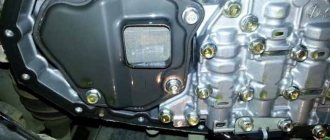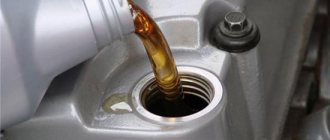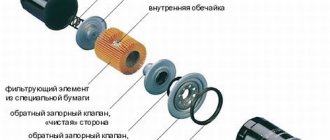Continuously variable transmissions, which provide smooth changes in speed, have been widely used in the automotive industry since the early 2000s. The owner needs to periodically check the condition of the vehicle and change the oil in the variator, ensuring an increase in the service life of the unit. If the maintenance regulations are violated, the wear of the bevel pulleys and leaf chain accelerates, which leads to expensive repairs.
The importance of lubrication for the functioning of the variator
The variator design has driving and driven cones; torque is transmitted by a plate steel chain. Special oil creates a thin layer that provides an increased coefficient of friction and at the same time reduces wear rates. The liquid removes metal dust, which can destroy bearings and damage the surfaces of cones or belts. The lubrication system has a filter that traps foreign impurities.
When the oil degrades, the operating conditions of the gearbox worsen, which leads to the vehicle going into emergency mode and failure of the unit.
To separate impurities, an external fine filter is used, located near the heat exchanger. On some CVT models (installed, for example, on a number of Mitsubishi cars) such an element is not provided. Inside the pan there is a coarse filter, which is changed only when the box is fully serviced.
What to use for the variator
The choice of lubricant for CVT gearboxes is subject to increased requirements. Unlike engine oils, it is not recommended to use analogues or experiment with interchangeable compounds.
Always choose the oil for your CVT that is specified in the manufacturer's recommendations.
Many are sure that there is no difference between oils for a CVT and a classic automatic transmission, that is, a torque converter. This is a misconception.
ATF and CVTF lubricants solve slightly different problems. Automatic transmission oils are aimed at ensuring hydraulic transformation of torque and providing lubrication for internal moving elements.
And oils for the variator lubricate and prevent the pulley from slipping. Because of this, the two types of lubricants differ significantly in composition and properties.
ATF and CVTF oils are completely incompatible with each other.
The only correct solution is to look at the instruction manual and find out which lubricant is suitable for the specific variator installed on the car.
Each auto company offering cars with CVT has its own recommended lubricants. Here are some examples:
- For Nissan vehicles, use CVT lubricants labeled NS1, NS2 and NS3.
- For these Japanese cars, the current version of the required oil is called Fluid J4. Although previously it was recommended to use Fluid J1. Oils are considered interchangeable.
- The Japanese company offers 2 types of lubricants for its machines. These are Fluid FE and Fluid TC. They have different markings and characteristics. They differ in additives. The FE version is more modern and can be used together with the conventionally outdated TC.
- HCF2 and HMMF lubricants are offered for these cars. But it is important to consider that they are not interchangeable.
- CVTs are also installed here, and they require G052 180A2 oil. The only regulated analogue is Febi 27975. The same lubricants are suitable for CVT on Volkswagen, Skoda and Seat cars.
- It is recommended to fill in different lubricants, depending on the model. CVT Lineatronic II composition is suitable for Lineatronic boxes. A special C30 fluid is supplied to the USA. ICVT FG lubricants are suitable for Subaru small cars.
- Elfmatic CVT oils are used here. An analogue is oil from Nissan NS2.
There really are a lot of options if you look at the big picture. But in fact, the motorist is limited in choice, since only original lubricant should be filled.
Yes, it is expensive, but it fully justifies its cost with a long service life and minimal intervention in the design with proper operation.
How to check the condition of the oil?
The following methods are used for verification:
- Drip testing, in which liquid is applied to a napkin or sheet of white paper and the amount of impurities is assessed. Please note that some of the metal shavings are caught by a magnet located in the tray of the box. To improve the quality of the visual assessment, it is recommended to apply a drop of pure oil. With prolonged use, the shade of the liquid changes, which is a sign of degradation.
- Electronic. The oil condition is determined by the control unit based on operating time and operating conditions. You can read the information using a diagnostic scanner. After filling with fresh fluid, the readings are reset, otherwise it is impossible to determine the degree of oil degradation in the variator. Similar systems are available in Toyota or Nissan gearboxes.
When to replace
Let's start with the frequency of oil changes in CVTs, which is always prescribed by the manufacturer in the instruction manual.
A continuously variable transmission has similar symptoms of malfunctions as in the case of a conventional automatic or manual transmission. If you notice uncharacteristic changes in the behavior of the CVT, you need to check the oil.
Mostly, problems with operation are caused by a drop in the level of lubricant or a decrease in its quality.
It is difficult to say exactly how long it takes to change the oil in your CVT. The regulations for most cars require that scheduled replacements be carried out at intervals of 40 thousand kilometers. If you make allowances for difficult operating conditions, then this interval is reduced to 30-35 thousand kilometers.
Before changing the oil in a CVT variator, you need to check its current condition and select a lubricant that suits its characteristics.
Replacement can be complete or partial. Each option has its own rules and recommendations.
Partial replacement allows you to update the lubricant in several stages. A complete replacement is more complex and involves additional dismantling work.
Having waited until the moment when you need to change the oil in your variator, choose the appropriate replacement method. Both options can be implemented with your own hands.
Be sure to check the instruction manual. Here it is indicated in kilometers how long it takes to change the lubricating oil in the variator according to the regulations. For Russian conditions, feel free to subtract about 20-30% from this value. That is, the actual frequency will be lower in comparison with the scheduled one.
The most correct way to determine the service life and interval between replacements is to take into account the operating conditions, the behavior of the car and reading data from the oil aging counter in the CVT.
How often should the oil be changed?
Methods for determining the state of the working fluid do not allow assessing the degree of degradation of components. Oil may maintain the original clarity, but may not provide the necessary frictional force at the point of contact between the belt and cones. The replacement interval is indicated by the manufacturers in the operating instructions. If the factory provides for the use of fluid throughout the entire life of the variator, then the recommendations of service stations should be taken into account.
After purchasing a used car, it is necessary to carry out extraordinary maintenance with the replacement of all technological fluids, regardless of mileage or information received from the previous owner. The buyer cannot know the quality and brand of the liquid poured in and the correctness of the work. For example, some owners neglect to replace the filter, reducing maintenance costs.
A cartridge clogged with dirt does not catch metal dust, which gets into the bearings and under the belt, causing abrasive wear of the variator.
Misconception: The variator is filled with oil for its entire service life.
One sentence contains two inaccuracies. Firstly, the liquid poured into the variator should not be called oil. Just as a classic automatic transmission uses ATF fluid, CVTs use a fluid with its own set of characteristics. Yes, lubricant is present in this list, but this is not the main purpose of such a liquid. For example, working fluid for a variator under pressure increases the coefficient of friction at the point of contact of the cone with the variator belt. Is regular oil capable of this? Of course not.
In classic automatic machines, non-metallic friction linings wear out more. And the variator has steel cones and a belt. Steel dust interferes with the operation of the valves; it can leave the system without fluid pressure, which is necessary for the operation of all automatic transmissions. Therefore, replacing the fluid every 60,000 km is necessary. At the same time, the catching magnets are cleaned of wear products and the filter is changed.
This is interesting: When to turn the steering wheel when turning
Operating features affecting the replacement interval
The service life of the fluid under normal operating conditions (when driving on hard-surface roads with the interior and trunk loaded not exceeding the standard) is 40–45 thousand km. Under increased loads, the degradation process accelerates, which leads to a drop in service life by 15–20%. The rule applies to all fluids used in V-belt automobile CVTs.
Negative factors affecting the reduction of oil life in a continuously variable transmission are the following:
- constant use of a vehicle with a trailer;
- driving in urban environments with frequent sudden changes in speed;
- driving in dense traffic jams, causing overheating of the variator;
- operating a vehicle in unfavorable road conditions with wheel slipping and constant switching of the direction of movement;
- repair of the box due to detection of a leak through the seals or gaskets.
Do I need to change the filter when changing the oil?
CVTs from the manufacturer Jatco are factory equipped with two filters:
- Disposable fine cleaning cartridge. Absent on some modifications, including the F1CJA and W1CJA versions. This element must be changed at every oil change. Its cost cannot be called high.
- Metal coarse filter. This part must be replaced every time the transmission fluid is changed. Otherwise, you can save money, but before that you need to clean the filter from metal shavings.
Reuse of the coarse filter is not allowed if its lattice part is clogged with resinous glue, which is used in the construction of friction linings.
We invite you to watch a video review of changing the oil and filters in the CVT of a 2012 Nissan Qashqai.
Full and partial oil change in the variator
A partial replacement involves draining 70–75% of the existing fluid and then bringing the level to the standard value. To increase the efficiency of maintenance, you can repeat the procedure 2-3 times, improving the concentration of fresh oil in the crankcase. The fine filter remains factory, which negatively affects the degree of liquid purification. If clogged, the element will not be able to retain wear products. The advantage of the technique is the simplicity of the work. Draining and refilling does not require special equipment or tools.
A brief algorithm of actions for partial replacement:
- Warm up the transmission and fluid to operating temperature by driving a distance of 10–15 km in summer and 20–25 km in winter.
- Place the car in a box with an inspection hole or on a lift.
- Keep the machine stationary using chocks installed under the wheels.
- Remove the engine and gearbox protection.
- Wipe the housing surfaces around the plugs and dipstick hole.
- Unscrew the filler plug or remove the dipstick from the crankcase cover.
- Unscrew the drain plug and place a previously prepared container.
- After draining is completed, replace the plug with a new sealing gasket.
- Remove the fine filter (if equipped) and install another cartridge.
- Using a transmission syringe, pour fresh fluid into the crankcase, bringing the level to the corresponding mark on the dipstick.
- Install the dismantled structural elements of the car in their original places, remove the stops and travel for a distance of 5–10 km. Check the level and, if necessary, add fluid to the variator crankcase.
For a complete replacement you need:
- Warm up the box and drive the car onto a lift or into the garage.
- Remove the protection elements of the gearbox and engine crankcases, then drain the fluid and unscrew the sump mounting bolts.
- Wash the metal tray from chip deposits.
- Remove the coarse and fine filters, and then install new elements. At the same time, change the sealing rings provided on the coarse filter.
- Reinstall the pan using a new gasket. When tightening screws, observe the sequence and torque. Violation of the requirements leads to leakage and damage to the thread.
- Fill the crankcase with fresh fluid using a transmission syringe or funnel. The volume must meet the requirements. Filling with excess oil is prohibited.
- Make sure the fluid level is correct using a dipstick that has volume notches in hot and cold states.
- Reinstall the removed protective elements.
- Reset the oil condition counter using the diagnostic scan tool. Do not operate the vehicle without resetting, as the control unit issues incorrect commands that accelerate wear of the variator.
- Take a test drive and check the level. If necessary, add liquid.
Which is better – complete or partial fluid replacement?
You cannot get by with only partial replacement of transmission oil over a long period of time. The fact is that when adding fluid, it is impossible to completely get rid of the chips that appear as a result of friction of the mechanisms inside the variator. Over time, it penetrates deeper into the design of the continuously variable transmission, eventually reaching the torque converter.
A complete oil change is something you shouldn't skimp on. You need to contact a car service, which takes time and money, but in the future, repairing the variator will cost more.
What do car owners think about partial oil changes in the variator?
When the variator operates, metal shavings are formed, which is normal. The number of particles is always higher than in a hydromechanical box, so manufacturers put 1 or 2 magnets in the gearbox pan. Overgrowing of the surface with metal shavings leads to the appearance of a suspension of foreign impurities in the liquid, which causes accelerated wear of the variator. A partial oil change does not allow cleaning the magnets. Draining the fluid removes metal shavings from the crankcase.
After a partial replacement, vibration in motion may be observed due to wear debris entering the torque converter clutch. Chips can be removed by partial replacement 3–4 times. The liquid will gradually wash away the contaminants. But if the vibrations remain, you need to remove the pan. Do not wash the coarse filter and install the element again. The pores of the paper filler cannot retain metal particles, and cellulose fragments clog the fine filter.
What kind of oil to pour into the variator
The long service life of a car depends, among other things, on the transmission fluid correctly selected by the automaker. Therefore, when completely or partially changing the oil in the variator, it is advisable to choose the original lubricant that fully corresponds to the characteristics of the vehicle. Do not be afraid of the high cost of a canister of such liquid. In the future, this will pay off in savings on repairing or replacing the gearbox. CVT oils differ from each other mainly in viscosity at different temperatures, density and acid number. Be sure to take these parameters into account when choosing a lubricant.
It is best to find out the appropriate brand of lubricant for a particular car from the service book, which, in addition to the recommended fluids, indicates the frequency of their complete or partial replacement.
- Oil for Nissan variator
The lubricant for this gearbox is characterized by minimal oxidation, which makes it possible to operate the vehicle for a long time under conditions of high loads and large temperature changes. Original brands of oils for these cars: CVT NS-1, CVT NS-2 and CVT NS-3. - Oil for Mitsubishi variator
Initially, the Mitsubishi gearbox is filled with CVT Fluid J4 lubricant. Previously used Dia Queen CVT Fluid-J1. Both options are interchangeable.These brands are suitable for use in Mitsubishi Lancer, RVR, Outlander, Delica D5, ASX and Galant Fotris. In addition, after planned partial and complete changes, the oil is successfully used in other platform cars: Peugeot 4007 and 4008, Citroen C-Crosser and C4 Aircross, Nissan NS-2. The fact is that this lubricant was developed for Jatco CVTs, which are also installed on these car brands.
- Oil for Toyota variator
Two types of fluids are produced specifically for Aisin CVTs (CVT Fluid TC and CVT Fluid FE). They differ from each other in characteristics and markings. The fluids contain various additives, including boron, calcium (has neutralizing properties), phosphorus (resists wear).CVT Fluid FE is a more modern brand with advanced additives, thanks to which the car can be operated at extremely low temperatures without problems. The lubricant is fully compatible with its counterpart CVT Fluid TC, including during partial changes.
In addition to Toyota, this oil is suitable for use in Lexus and Daihatsu.
- Honda variator oil
Typically, these cars use 2 types of fluids: CVT Fluid HCF-2 and CVTF (or HMMF). However, unlike the previous case, these types of oils are not interchangeable. Therefore, before making a partial or complete replacement, you should find out which type of lubricant is best suited to a particular vehicle. This information is given in the attached service book.Lubrication is produced using innovative Idemitsu technology, thanks to which the gears on the variator shift smoothly even in difficult conditions. CVT Fluid HCF-2 brand fluid should be poured into the 2nd generation CVT box, which is equipped with models starting with Accord 2013 and Honda Fit 2015. Use this product in 1st generation CVTs produced before 2013 during a full or partial change unacceptable.
We recommend
“Ford Focus 3 box repair: problems and necessary operations” Read more
- Audi CVT oil
The original product for Audi CVTs is ATF G052 180 A2. It can be replaced with a similar lubricant, Febi 27975. About 6 liters of fresh oil are needed to completely replace the fluid and clean the variator from contaminants.In addition to Audi, this product is successfully used in Skoda, Seat and Volkswagen cars.
- Subaru variator oil
CVT Oil Lineartronic II fluid is produced especially for the Impreza and XV models equipped with the Lineartronic TR-580 CVT gearbox. Production of the first modification of the product has been discontinued. In addition, Subaru supplies CVT C-30 OIL lubricant to the American market for complete or partial replacement.As for small-displacement models such as R1 and R2, it is recommended to fill their variators with I-CVT FG lubricant.
- Renault CVT oil
Cars of this brand are equipped with Jatco CVTs, for which the manufacturer supplies Elfmatic CVT transmission lubricant. As an analogue, during a partial or full shift, Nissan NS-2 transmission fluid is poured, and in rare cases NS-3. - Suzuki variator oil
For cars with a Jatco JF011E gearbox, the manufacturer recommends the original CVT Fluid Green 1 lubricant. In models with Jatco JF015E and JF016E CVTs, it is recommended to use the branded CVT Fluid Green 2 oil.Instead of original fluids from Suzuki, during a complete or partial change, it is permissible to use Nissan NS-2 and Mitsubishi J1 oils; in extreme cases, CVT-F from Idemitsu is also suitable.
Checking status
You can check the condition of the lubricant using direct and indirect signs.
Motorists mainly use the following methods:
- Checking the level. The first step is always to check the amount of lubricant to ensure it meets the requirements. If there is enough oil, but the gearbox malfunctions, then you need to check the quality.
- Drop samples. Here you will need a dipstick to check the level. You need to take a clean white napkin, insert the dipstick into the neck, pull it out and blot the napkin. If any foreign particles are present, the color is no longer transparent or has changed, then it is time to change the oil.
- Smell. By the smell you can detect signs of burning. This suggests that the lubricant has repeatedly overheated, and therefore has probably lost its properties and characteristics.
- Data from the oil aging counter. The electronic unit of many cars involves the use of an algorithm for taking into account the age of the lubricant and its condition. To do this, you need to connect to the electronic unit via a special adapter or simply a mobile application. Go to the appropriate section and look at the number of points reflecting the quality of the oil.
Each automaker gives its own recommendations regarding replacement according to the aging counter. But in most cases it is 150-200 thousand points.
There are also indirect signs of checking the condition of the oil in the CVT. They manifest themselves in the behavior of the car:
- the car accelerates poorly;
- the start is very difficult;
- when accelerating, the car jerks;
- conditional gears are difficult to switch;
- When moving to the neutral position of the selector, the car moves.
This does not directly indicate that the reason for this behavior is in the oil. But there is a high probability of his guilt.
Transmission oil recommended by the manufacturer
For RE0F09B and RE0F10A transmissions, the manufacturer recommends using only genuine Nissan NS-2 or NS-3 transmission fluid, and warns that the use of other lubricants may damage the CVT.
But practice shows that there is a completely worthy alternative to the original, for example, Ravenol CVTF NS2/J1.











